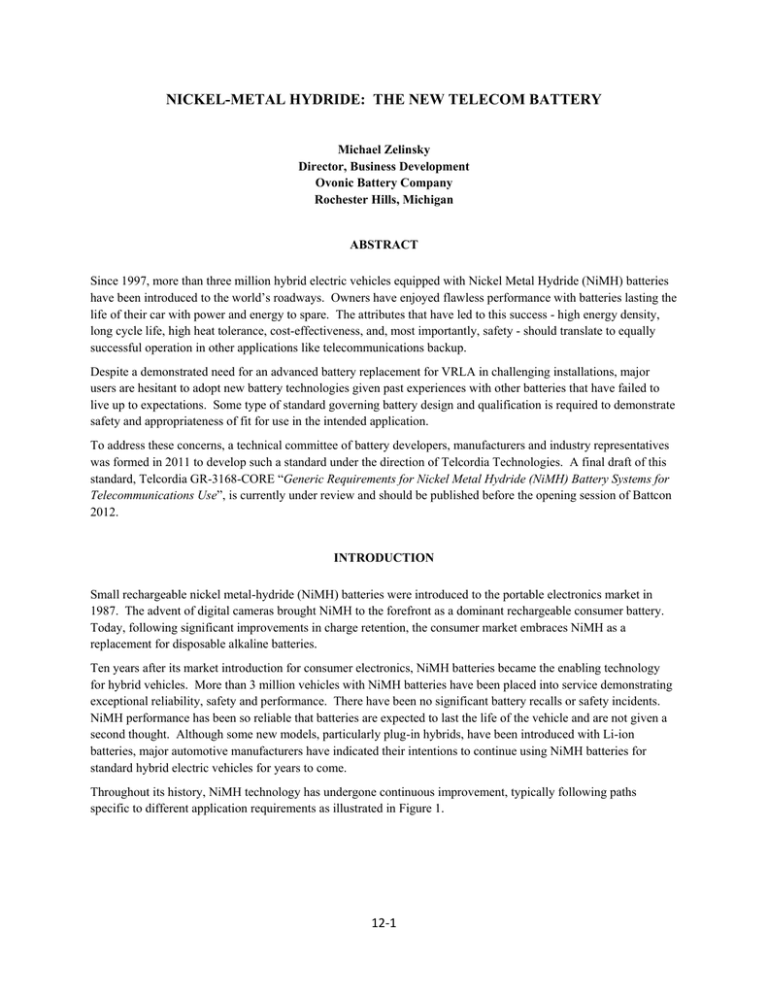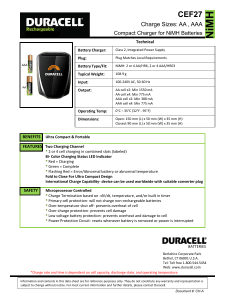nickel-metal hydride: the new telecom battery
advertisement

NICKEL-METAL HYDRIDE: THE NEW TELECOM BATTERY Michael Zelinsky Director, Business Development Ovonic Battery Company Rochester Hills, Michigan ABSTRACT Since 1997, more than three million hybrid electric vehicles equipped with Nickel Metal Hydride (NiMH) batteries have been introduced to the world’s roadways. Owners have enjoyed flawless performance with batteries lasting the life of their car with power and energy to spare. The attributes that have led to this success - high energy density, long cycle life, high heat tolerance, cost-effectiveness, and, most importantly, safety - should translate to equally successful operation in other applications like telecommunications backup. Despite a demonstrated need for an advanced battery replacement for VRLA in challenging installations, major users are hesitant to adopt new battery technologies given past experiences with other batteries that have failed to live up to expectations. Some type of standard governing battery design and qualification is required to demonstrate safety and appropriateness of fit for use in the intended application. To address these concerns, a technical committee of battery developers, manufacturers and industry representatives was formed in 2011 to develop such a standard under the direction of Telcordia Technologies. A final draft of this standard, Telcordia GR-3168-CORE “Generic Requirements for Nickel Metal Hydride (NiMH) Battery Systems for Telecommunications Use”, is currently under review and should be published before the opening session of Battcon 2012. INTRODUCTION Small rechargeable nickel metal-hydride (NiMH) batteries were introduced to the portable electronics market in 1987. The advent of digital cameras brought NiMH to the forefront as a dominant rechargeable consumer battery. Today, following significant improvements in charge retention, the consumer market embraces NiMH as a replacement for disposable alkaline batteries. Ten years after its market introduction for consumer electronics, NiMH batteries became the enabling technology for hybrid vehicles. More than 3 million vehicles with NiMH batteries have been placed into service demonstrating exceptional reliability, safety and performance. There have been no significant battery recalls or safety incidents. NiMH performance has been so reliable that batteries are expected to last the life of the vehicle and are not given a second thought. Although some new models, particularly plug-in hybrids, have been introduced with Li-ion batteries, major automotive manufacturers have indicated their intentions to continue using NiMH batteries for standard hybrid electric vehicles for years to come. Throughout its history, NiMH technology has undergone continuous improvement, typically following paths specific to different application requirements as illustrated in Figure 1. 12-1 1600 2007 Power Tools, RC Toys Specific Power (W/kg) 1400 2004 HEV 1200 2000 HEV 1000 2003 Power Tools, RC Toys 800 1997 High Power Devices 600 2000 Scooters, Bicycles 400 200 Market Introduction 1995 Portable Electronics 2006-2007 0 40 45 50 55 60 65 70 75 80 85 90 95 100 105 110 115 120 Specific Energy (Wh/kg) Figure 1: Evolution of NiMH Technology In recent years, research efforts have focused on development of higher temperature and lower cost electrode materials. These improvements, coupled with demonstrated high energy density and long operating life make NiMH an extremely attractive candidate for use in stationary applications, particularly telecom. What has been missing is an accepted, standardized method of demonstrating safety and performance. GR-3168-CORE Similar to other Telcordia battery standards, GR-3168-CORE “Generic Requirements for Nickel Metal Hydride (NiMH) Battery Systems for Telecommunications Use” provides a 3-tiered framework for evaluating and qualifying various NiMH batteries for telecom deployment; basic safety for laboratory testing, enhanced safety for limited field trials, and abuse tolerance for full deployment. The content is largely derived from long established Telcordia generic requirements for VRLA and NiCd batteries along with enhanced features taken from newer Li-ion battery standards. One of the largest challenges faced by the drafting committee was to ensure that the all meaningful content from previous standards was incorporated while presenting the requirements in a manner that would be applicable to NiMH technology. For example, many testing conditions common to VRLA are specified in 24 cell strings with discharge limits based on a 2V cell voltage. The voltage of a NiMH cell is 1.2V and the number of cells used per string can vary from one product to the next. Another challenge was to ensure that user’s needs would be met while not unduly burdening the technology. For example, when GR-3150 was drafted for lithium batteries, a very cautious approach was taken requiring these batteries to include full monitoring, diagnostic, and remote communication requirements. It is tempting to apply these same requirements to all advanced batteries, but many NiMH battery products in use today do not contain any electronics whatsoever. 12-2 Specific sections of the standard outline deployment considerations for central office, outside plant, and customer premises - including environmental and electrical requirements; general product requirements, including design elements, materials, labeling, documentation, etc.; safety criteria, both electrical and mechanical; performance criteria under various conditions; and service life modeling under temperature cycles designed to simulate solar load and temperature variations. This last section is particularly interesting as it has been reported on numerous occasions how exposure to elevated temperatures can lead to premature failure of VRLA batteries, yet this is one of the strengths of NiMH technology. 120 % Charge acceptance 100 80 GR-3168 requires performance characterization after one week of daily thermal cycles ranging from 45⁰ to 65⁰C (55⁰C average). The laboratory test data in Figure 2 shows results on 5 hour discharge after 24 hours of charging at elevated temperature. 50⁰C temperature has almost no effect on the battery and greater than 60% charge acceptance is achievable at 75⁰C. 60 40 20 0 25 50 65 Temperature (⁰C) 75 Figure 2: Charge acceptance at elevated temperature BATTERY DESIGN CONSIDERATIONS Cell Design NiMH batteries can be constructed of either large-format prismatic cells or multiple strings of smaller cylindrical cells. The choice of cell design will not only impact overall performance, but will have different outcomes on specific test conditions. Throughout the electrical abuse testing section of GR-3168, there is a clear objective to not only ensure safety but to maintain power to the equipment wherever possible. The unlikely failure of one or more cells in module of small cylindrical cells would simply reduce the available runtime, while a similar situation in a single string of large cells could potentially interrupt power to the load. The choice of materials used in the cell can also impact performance. GR-3168 specifies 50% capacity retention after six months storage without charging. Depending on the choice of nickel hydroxide, metal hydride alloy, and separator, self discharge of NiMH cells can range from 1% per day to less than 1.5% per month. Number of Cells per String As mentioned earlier, the nominal cell voltage of NiMH is 1.2V suggesting that 40 cells are required for a nominal 48V string. However, because of charging voltage limitations, there can be a trade-off between the number of cells and reserve capacity. GR-3168 specifies that float voltage in the OSP is limited to 56.0V, desired to not exceed 55.2V and preferred to be in the range 53.8 – 54.8V. The preferred range for CO installations is 52.08 – 52.8V. Batteries are required to reach 90% state of charge after 24 hours. 12-3 Figure 3 illustrates 24-hour charging profiles of 40 cell strings at the preferred upper and lower float limits for OSP and CO along with their associated 8-hour discharge curves. Only the strings charged at the highest voltage reach the required 90% capacity. 120 60 Charge termination - 24 hr limit 55 80 Voltage (V) Capacity (Ah) 100 60 40 20 50 45 40 35 0 30 0 5 10 15 Time (Hrs) OSP (55.2 V Upper Charge Limit) CO (53.52 V Upper Charge Limit) 20 25 30 0 20 40 60 Capacity (Ah) OSP (55.2 V Upper Charge Limit) CO (53.52 V Upper Charge Limit) OSP (53.8V Lower Charge Limit) CO (52.08 V Lower Charge Limit) 80 100 OSP (53.8V Lower Charge Limit) CO (52.08 V Lower Charge Limit) Figure 3: Charge and discharge of 40 cell strings (100 Ah) If, however, the string is reduced to 38 cells, the results are much more favorable as shown in Figure 4. 60 Charge termination -105% limit 100 55 80 50 60 Voltage (V) Capacity (Ah) 120 Charge termination - 24 hr limit 40 45 40 35 20 0 30 0 5 10 15 Time (Hrs) 20 25 30 0 20 40 60 Capacity (Ah) 80 100 OSP (55.2 V Upper Charge Limit) OSP (53.8 V Lower Charge Limit) OSP (55.2 V Upper Charge Limit) OSP (53.8 V Lower Charge Limit) CO (53.52 V Upper Charge Limit) CO (52.08 V Lower Charge Limit) CO (53.52 V Upper Charge Limit) CO (52.08 V Lower Charge Limit) Figure 4: Charge and discharge of 38 cell strings (100 Ah) Battery Design Based on the long history of NiMH technology in the field, it is generally accepted that a battery management system (BMS) is not required to ensure safety. However, to ensure optimum performance and operating life, use of a BMS is strongly recommended. With 38 cells per string and the likelihood that multiple strings will be connected in parallel, it is envisioned that battery manufacturers will utilize BMS circuitry to control charging, monitor battery parameters, and communicate status. GR-3168 requires that NiMH battery modules that utilize a BMS must contain a state of health indication and, at a minimum, be capable of communicating a major fault via a form-C relay contact. Additional monitoring, diagnostic, and communication features are encouraged and may be incorporated into the battery or housed in a separate module. 12-4 PRODUCT EXAMPLES Several NiMH products of vastly different design have been introduced to the stationary market recently. These batteries offer attractive benefits to telecom service and may soon be subject to the specifications of GR-3168. Design #1 – compact, 12V60Ah and 24V30Ah battery modules are currently on field test with several independent telecom customers in high-temperature remote installations. Modules are assembled with cylindrical NiMH D cells, 10 per nominal 12V string, and have a built-in BMS that interfaces with a patented battery management, monitoring, and communication system which allows remote monitoring and control. Design #2 – based on large-format prismatic NiMH cells used in EV applications, 10-cell, 12V100Ah battery modules are currently being field tested in a shipyard crane application. With the same footprint as 12V100Ah VRLA, but 1/3 shorter and almost half the weight, these batteries are quite attractive for the telecom OSP. Design #3 – a 19” rack mountable modular 48V NiMH battery system was unveiled earlier this year. Based on 36cell strings, six parallel strings provide 19Ah capacity in a 1U module. Up to 26 modules can be stacked together to with a single master control unit to create a 23.7 kWh system. Several systems are currently undergoing field testing with telecom customers in Japan. GOING FORWARD Although promising, all of these products may face challenges when they are subjected to GR-3168. For example, as outlined earlier, battery designs based on 40 cells for a nominal 48V string may not charge completely while designs based on 36 cells could suffer reduced capacity due to high per cell cutoff voltage. While the cells used in all of these products will display superior operating temperature range compared to VRLA, they may have challenges meeting the extreme temperature requirements of GR-3168 since the electronic control circuitry they contain must also survive. Finally, many of the specified mechanical and electrical abuse conditions have never been tested on a complete NiMH battery system. As such, surprise results could require redesign and retesting. Ovonic believes NiMH technology will bring significant value to the telecom customer. We are committed to working with our licensees, to assist them in commercializing stationary NiMH batteries through performance characterization to identify weak links, assisting with design improvements, developing advanced battery materials, and coordinating testing and certification to GR-3168. CONCLUSION NiMH battery technology offers a promising alternative for use in challenging telecom applications. Nonetheless, major customers are reluctant to embrace new battery technologies without some type of standard governing battery design and qualification to demonstrate safety and appropriateness of fit for use. Telcordia GR-3168-CORE, “Generic Requirements for Nickel Metal Hydride (NiMH) Battery Systems for Telecommunications Use” was created to fill this need and will soon be applied to a number of NiMH batteries that have been introduced to the stationary market. 12-5

